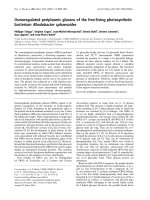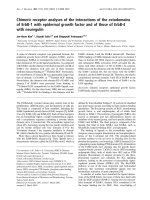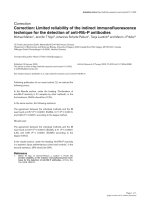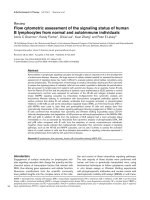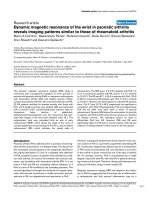Báo cáo y học: " Carinal surgery: experience of a single center and review of the current literature" potx
Bạn đang xem bản rút gọn của tài liệu. Xem và tải ngay bản đầy đủ của tài liệu tại đây (823.03 KB, 7 trang )
Parissis and Young Journal of Cardiothoracic Surgery 2010, 5:51
/>Open Access
RESEARCH ARTICLE
© 2010 Parissis and Young; licensee BioMed Central Ltd. This is an Open Access article distributed under the terms of the Creative Com-
mons Attribution License ( which permits unrestricted use, distribution, and reproduc-
tion in any medium, provided the original work is properly cited.
Research article
Carinal surgery: experience of a single center and
review of the current literature
Haralabos Parissis*
1
and Vincent Young
2
Abstract
Background: To report our experience for the treatment of lung tumors of the right main bronchus (RMB) invading
the carina.
Methods: From February 2000 till January 2007 we have identified 8 cases (1.09%) requiring carinal surgery.
Plan of action: Close cooperation with anaesthetics, long flexible ET tube, Right posterolateral thoracotomy, no
irrevocable steps until resection guaranteed, mobilization of trachea and main bronchus, division of the trachea & Left
main bronchus. Intubate across surgical field. Tailoring for airway size discrepancies, appropriately. Construction of the
tracheobronchial anastomosis around the ventilatory tube. Skillfull reintubation, over a long boogie.
Results: Mortality: 12.5% due to ARDS (one patient)
Morbidity: anastomotic stenosis requiring stent (one patient). Follow-up 52 ± 11 months.
Recurrences: 2 patients (both with pathological N2 disease on histology).
Conclusions: Success of carinal surgery depends on careful patient selection, team approach and attention to detail.
Patients with N2 disease carry the worst prognosis.
Background
Until recently the TNM classification staged tumours
invading the carina as T4, IIIB. By implication these
tumours are inoperable due to local criteria. However a
subgroup of those patients can be treated by carinal
resection and reconstruction with potential cure. There-
fore, there is an argument that this subgroup should the
staged as IIIA[1]; especially since this small group of
patients consists of a potentially surgical group with
favourable outcome and a five years survival up to 40%-
45% [2].
Indications for carinal resection are reported [3] as:
bronchogenic carcinoma (43.2%), other airway neo-
plasms (44.7%) and benign or inflammatory strictures
(11.9%).
In this report we are presenting our experience with
right side carinal pneumonectomy and carina plasty. The
indications, surgical steps and early outcome are
reported.
Methods
Our series of carinal surgery consists of a small number
of patients performed by a single surgeon (the senior
author of the paper, VY).
From February 2000 up till January 2007 we have iden-
tified 8 cases (1.09% of all pulmonary resections) of cari-
nal surgery in our institution: 5 cases of right side carinal
sleeve pneumonectomy (CSP) and 3 cases of carinal
plasty (resection of the carina with preservation of both
left and right lung).
CSP was considered when there was suitable anatomy,
clinical N0, N1 disease, stump recurrence following
lobectomy or positive margins after right side pneumo-
nectomy and carcinoid/sarcoma of the carina. Written
informed consent was obtained from the patients for this
publication.
Left carinal pneumonectomy was not encountered in this
series
The rate of false negative pre-operative CT evaluation of
the mediastinum could be up to 35%; moreover the sensi-
tivity and specificity of CT staging of the mediastinal
nodal involvement is 78% [4]. For those reasons, all the
* Correspondence:
1
Cardiothoracic Department, Royal Victoria Hospital, Belfast, Northern Ireland
Full list of author information is available at the end of the article
Parissis and Young Journal of Cardiothoracic Surgery 2010, 5:51
/>Page 2 of 7
patients in these series had undergone PET scan and
mediastinoscopy (Figure 1).
Preoperative N2 disease was a contraindication for
carina surgery. Therefore neoadjuvant downstaging was
not considered in those series.
Brain CT in our institution is carried out only when
there are clinical signs or symptoms of brain metastasis.
Likewise bone scan is deemed necessary only when bone
pain, hypercalcaemia or high alk phosphatase is present.
Assessment by rigid bronchoscopy and biopsy of the
lower trachea/carina/right main bronchus is also carried
out to further delineate the extent of the tumor involve-
ment (Figure 2).
A favourable outcome following CSP is feasible if opti-
mal anaesthetic and surgical strategies are to be taken
into consideration.
Anaesthetic strategies
Multidisciplinary team approach and close collaboration
with the anaesthetist, is required.
Long flexible Endo Tracheal (ET) tube, is used. No irre-
vocable steps are taken until the resection is guaranteed.
Intraoperative barotrauma has to be eliminated by avoid-
ing long periods of collapsed lung. Finally, after the poste-
rior part of the tracheobronchial anastomosis has been
constructed, skillfull reintubation over a long boogie is
required.
Surgical strategies
We advocate right posterolateral thoracotomy through
the 5
th
intercostal space.
Mediastinal lymph node resection (stations R2, 4, 7, 8,
9) is carried out routinely in our department. The lower
trachea and left main bronchus (LMB) are mobilized. The
exposure is usually better facilitated, following dissection
and removal of station 7 lymph nodes. Bronchial vessels
in the subcarinal region are dealt with diathermia.
We use traction sutures on the lower trachea and a tape
around the LMB, prior to division. Following division of
the LMB, we ensure across surgical field intubation with a
small size ET tube to maintain ventilation of the left lung.
Figure 1 Staging algorithm for patients prior to carinal resection.
Staging
Algorithm
Mediastinoscopy
proven N2 nodes
Lung Cancer
Positive
Bone Scan
Liver or
Adrenal mets
Brain Mets
on CT
Headaches
CT Thorax/
Upper Abdomen
& PET Scan
Bone Pain
Weight loss
Hypercalcaemia
Enlarged
mediastinal
nodes
No Operation
Resection
Mediastinoscopy
Clear
Parissis and Young Journal of Cardiothoracic Surgery 2010, 5:51
/>Page 3 of 7
Figure 2 A case of a central Squamous cell carcinoma of the Right upper lobe invading the carina. CXR, CT Scan of the chest, PET scan, sche-
matic representation of the tumor and Bronchoscopy before and after carinal resection showing tracheo-bronchial anastomosis.
Parissis and Young Journal of Cardiothoracic Surgery 2010, 5:51
/>Page 4 of 7
Frozen sections are only required if R0 resection margins
are "macroscopically questionable" (none of our reported
cases). Up to two tracheal rings can be removed without a
danger of putting the anastomosis under tension. The
construction of the end to end or end to side airway anas-
tomosis is fashioned with a continuous 3.0 prolene. The
back wall is completed first, following by endotracheal
intubation across the anastomosis. The front wall is then
done over the long ET tube; care must be taken to avoid
"incorporating the ET tube" on the suture line. Flexible
Bronchoscopic inspection of the suture line is performed
routinely. Traditionally in our institution, we used
prolene suture for all bronchial surgery (closure of a
stump, sleeve lobectomy or bronchoplasty procedures).
Discrepancies in size are less of a problem than in simple
sleeve lobectomy; but where encountered were dealt with
by careful adjustment of suture placement on the two air-
ways. Telescopic anastomotic technique due to differ-
ences in size was not encountered in those series.
Furthermore, we did not circumferentially wrap the anas-
tomosis with any viable tissue (eg. Omentum or intercos-
tal muscle).
Finally, specific release manoeuvres are not required
but there is considerable mobilisation of structures due to
the complete mediastinal nodal dissection performed in
all patients. This is an important technical as well as
oncological component of the operation.
Results
Our experience with carinal surgery, consists of 8
patients over a 7 year period. There were relative younger
patients (mean age 58 ± 3 years) compare to the age of the
overall lung resection patients (67 ± 8.3 years). The
patients were predominantly males with the histological
diagnosis of Squamous cell Carcinoma (Table 1). One
patient underwent a completion sleeve pneumonectomy:
he was a 57 year old male who in a routine follow up 5
years following Right middle & lower Lobectomy for
NSCLC he was found to have collapsed of the residual
lung. Bronchoscopy showed NSCLC involving the origin
of the right main bronchus. He underwent a completion
pneumonectomy with carinal resection. Finally, three
patients underwent carinal-plasty for tracheal sarcoma or
carcinoid tumours.
One patient died due to respiratory failure and ARDS
two weeks following surgery. One patient developed
anastomotic stenosis manifested five weeks postopera-
tively with stridor. He required dilatation and stenting
across the anastomosis. Two patients (both with patho-
logical N2 disease on histology) developed recurrences:
patient number 2 developed local recurrences 1 year later
and patient number 6 re-presented with brain metastasis
3 months after surgery.
Two patients with SCC were the long term survivors
following RSP at 50 and 39 months. Finally, the only
patient with the Tracheal sarcoma was alive at 29 months
and the 2 patients with the carcinoid tumors were alive at
26 and 28 months of follow up.
Discussion
Pathological processes that involve the carina pose a chal-
lenge to the thoracic surgeons.
Patients must be able to withstand the procedure, and
they must be told that the operative mortality is 2 to 4
times higher than what is expected after standard pneu-
monectomy [5]. Nevertheless, techniques have been
developed to allow primary resection and reconstruction
with relative moderate risk and a five year survival that
does not really reflect stage IIIB disease.
Our experience refers to limited number of cases, how-
ever useful thoughtful suggestions could be derived out of
it; those technically demanding operations are requiring
team approach and a sound decision making process.
Maintaining optimal oxygenation through out the pro-
cedure is desirable. There are various ventilation options
during construction of the airway anastomosis. Cross
field ventilation is the most common used technique but
requires close anaesthetic collaboration. Apnoeic oxygen-
ation operates on the principle that with preoxygenation
and hyperventilation 10-12 min of total apnea can be
safely tolerated. However, due to hypoxic complications a
modified technique is usually advocated whereby hyper-
oxygenation is followed by cross surgical field ventilation
with a 10F catheter and delivering 15 L/min O2. Finally,
high Frequency Jet Ventilation delivered through a small
bored catheter is infrequently implemented.
If the SVC is involved (up to 20% of the cases) then a
brain protection strategy during concomitant SVC sur-
gery is required. We advocate monitoring of the jugular
bulb pressure (JBP) and we aim to optimise cerebral per-
fusion pressure by increasing the MAP at least to 60
mmHg above the JBP. We also aim to keep the jugular
bulb oxygen saturation greater than 50%. Neither venous
shunt from the brachiocephalic vein to the right atrium
nor neuro-protective agents and mannitole has been used
by our group.
In order to achieve R0 resection margins, careful plan-
ning is essential. Accurate bronchoscopic biopsies along
the carina are obtained; distal sides are biopsied first.
Nevertheless, surgeons must always remember that it is
better and safer to accept a positive resection margin than
to have to deal with a bronchopleural fistula caused by
anastomotic separation [5]. This is because anastomotic
complications are often life-threatening [6]. The most
feared complication however, is postoperative adult
respiratory distress syndrome [7] encountered in up to
11% of the cases.
Parissis and Young Journal of Cardiothoracic Surgery 2010, 5:51
/>Page 5 of 7
The postoperative mortality was 12.5% in our series
due to ARDS. Mitchell et al [8] reported a 20% mortality
for Carinal Pneumonectomy and 11% for carinal plasty.
The overall mortality is high and this could be explained
by looking at the patients characteristics (Table 2): up to
20% of the patients in those series had previous lung sur-
gery and also up to 35% had previous chemoradiation for
downstaging [9-11].
Predictors of operative mortality included postopera-
tive mechanical ventilation, length of resected airway and
development of anastomotic complications [3].
The 5 year survival (Table 2) was low in the early series
[12] however late reports are quoting survival up to
44%[11,13];Moreover Mitchell et al [3] has calculated the
5 year survival according to the pathology of the disease
to be : 38% for Carinal Pneumonectomy and up to 51%
for carinal plasty. In our report out of 5 patients following
CSP, there was one operative death and 2 recurrences
within the first year. Two patients were intermediate sur-
vivors (e.g. alive 3-4 years later). Moreover, the 3 patients
that underwent carinal plasty were still alive 2 and half
years later.
Tumour recurrences are only mentioned in few reports
[10,11]; the recurrence rate in our series was 25% but it
has been quoted to be as high as 75% [14]. Furthermore
we observe a high local and distal recurrence rate in
patients with pathological N2 disease; this probably out-
lines aggressive disease and therefore a very close follow
up and post operative chemoradiation may be justified.
Nodal status Influences of the outcome according to
various reports [8,10,11,15,16]: patients with pathologi-
cally N2 disease have a 12% 5 year survival versus 53% for
N0.
The role of neoadjuvant Chemo-Radiation therapy is
debatable: According to some reports [9] it downstages
40% of N2 nodes therefore increases the pool of patients
that they would benefit from surgical resection; However,
according to other reports [17] this type of therapy
should be used with caution because of the deleterious
effects on anastomotic healing.
Radical lymphadenectomy is advocated in our centre
routinely. This was supported by other groups. The high
incidence of micrometastatic nodes in positron emission
tomography-negative patients according to Macchiarini
Table 1: Patients characteristics
Pt 12345678
Age 58 62 55 55 62 66 64 25
Sex MMMMF MF M
Procedure RSP RSP RSP RCSP CP RSP CP CP
LOS(days) 19 18 28 16 12 16 9 11
Complications Chest
infestion
Anastomotic
stenosis
ARDS arrhytmias
Histology SCCSCCSCCSCCTS SCCCarcinoidCarcinoid
TNM T4N0M0 T4N2M0 T4N1 M0 T4N1 M0 N0 T4N2 M0 N0 N0
Recurrence NoYesNoNoNoYesNoNo
Status AADAAAAA
Survival (months) A (50) D (12) D (1) A (39) A (29) D (3) A (26) A (28)
SCC: Squamous cell Carcinoma, RSP: Right Sleeve pneumonectomy, RCSP: completion sleeve pneumonectomy for T1N0 tumor removed with R
middle & lower lobectomy 5 years ago.
CP: carinal plasty with reinplantation of the right main bronchus to the trachea for Tracheal Sarcoma (TS) or carcinoid tumor
A:Alive
D:Dead
Parissis and Young Journal of Cardiothoracic Surgery 2010, 5:51
/>Page 6 of 7
et al [9] justifies routine mediastinoscopy and radical
lymphadenectomy.
Finally is Sleeve pneumonectomy a justifiable proce-
dure? The answer is negative, if the mortality rate is simi-
lar to the long-term survival and positive, if one can
achieve an operative mortality under 10% and a five year
survival over 20%.
Conclusions
The various techniques of carinal surgery could be
applied in selective cases with optimal outcome [18,19].
However, success depends on careful patient selection,
attention to detail and accurate preoperative staging [20].
The results reflect the technical complexity of the oper-
ation and the natural history of lung cancer but, five year
survival in excess of 40% for malignant disease may be
anticipated in the absence of involved mediastinal lymph
nodes.
Competing interests
The authors declare that they have no competing interests.
Authors' contributions
HP participated in the sequence alignment and drafted the manuscript and VY
participated in its design and coordination. The authors read and approved the
manuscript.
Author Details
1
Cardiothoracic Department, Royal Victoria Hospital, Belfast, Northern Ireland
and
2
Cardiothoracic Department, St James Hospital, Dublin 8, Dublin, Republic
of Ireland
References
1. Goldstraw P, Crowley J, Chansky K, Giroux D, Groome P, Rami-Porta R,
Postmus P, Rusch V, Sobin L: The IASLC Lung Cancer Staging
Project:Proposals for the Revision of the TNM Stage Groupings in the
Forthcoming(Seventh) Edition of the TNM Classification of Malignant
Tumours. Journal of Thoracic Oncology 2007, 2:706-714.
2. Yildizeli B, Dartevelle PG, Fadel E, Mussot S, Chapelier A: Results of
primary surgery with T4 non-small cell lung cancer during a 25-year
period in a single center: the benefit is worth the risk. Ann Thorac Surg
2008, 86:1065-75.
3. Mitchell JD: Carinal resection and reconstruction. Chest Surg Clin N Am
2003, 13(2):315-29.
4. Vansteenkiste JF, Stroobants SG, Dupont PJ, Mortelmans LA, De Leyn PR,
Verschakelen JA: Mediastinal lymph node staging with FDG-PET scan in
patients with potentially operable non-small cell lung cancer: a
prospective analysis of 50 cases. 1997. Chest 2009, 136(5 Suppl):.
5. Deslauriers J, Grégoire J, Jacques LF, Piraux M: Sleeve pneumonectomy.
Thorac Surg Clin 2004, 14:183-90.
6. Borri A, Leo F, Veronesi G, Solli P, Galetta D, Gasparri R, Petrella F,
Scanagatta P, Radice D, Spaggiari L: Extended pneumonectomy for non-
small cell lung cancer: morbidity, mortality, and long-term results. J
Thorac Cardiovasc Surg 2007, 134(5):1266-72.
7. Jiang F, Xu L, Yuan F, Huang J, Lu X, Zhang Z: Carinal resection and
reconstruction in surgical treatment of bronchogenic carcinoma with
carinal involvement. J Thorac Oncol 2009, 4(11):1375-9.
8. Mitchell JD, Mathisen DJ, Wright CD, Wain JC, Donahue DM, Allan JS,
Moncure AC, Grillo HC: Resection for bronchogenic carcinoma involving
the carina:long term results and effect of nodal status on outcome. J
Thorac Cardiovasc Surg 2001, 121:465-71.
9. Macchiarini P, Altmayer M, Go T, Walles T, Schulze K, Wildfang I, Haverich
A, Hardin M: Hannover Interdisciplinary Intrathoracic Tumor Task Force
Group. Technical innovations of carinal resection for nonsmall-cell
lung cancer. Ann Thorac Surg 2006, 82:1989-97.
10. Rea F, Marulli G, Schiavon M, Zuin A, Hamad AM, Feltracco P, Sartori F:
Tracheal sleeve pneumonectomy for non small cell lung cancer
(NSCLC): short and long-term results in a single institution. Lung
Cancer 2008, 61:202-8.
11. de Perrot M, Fadel E, Mercier O, Mussot S, Chapelier A, Dartevelle P: Long-
term results after carinal resection for carcinoma: does the benefit
warrant the risk? J Thorac Cardiovasc Surg 2006, 131:81-9.
Received: 6 March 2010 Accepted: 19 June 2010
Published: 19 June 2010
This article is available fro m: http://www. cardiothoracics urgery.org/con tent/5/1/51© 2010 Parissis and Young; licensee Bi oMed Central Ltd. This is an Open Access article distributed under the terms of the Creative Commons Attribution License ( s/by/2.0), which permits unrestricted use, distribution, and reproduction in any medium, provided the original work is properly cited.Journal of Cardiothoracic Surgery 2010, 5:51
Table 2: Characteristics and outcome following surgery for carinal pathology
Patients Characteristics [8,9] Histology [8,10] Complications 36-45% Concomitant
procedures
Mortality Mainly
due to MI, ARDS, PE
5 year
survival
Predominantly males(2/3) SCCa 70%-77% Arrhythmia 18.3% SVC Surgery 22% 4% [2] 15% [12]
Previous lung surgery: 14-21.6% AdenoCa 18%-20% Anastomotic leak 16.7% Excision of
diaphragm 3%
15% [8] 33.4% [13]
Previous chemoradiation: 15-36% Large Cell 2- 7% ARDS 10% Chest wall 2% 4% [9] 42% [8]
Carinal pneumonectomy: 58-68%
Carinal Plasty: 30% Stump
revision: 4%
Mixed 1-3% Pneumonia 6.7% LA 1% 7.6% [11] 44% [11]
References: [2,8-13]
SCCa: Squamous Cell Carcinoma
SVC: Superior Vena Cava
LA: Left Atrium
MI: Myocardial Infarction
ARDS: Adult respiratory distress Syndrome
PE: Pulmonary Embolism
Parissis and Young Journal of Cardiothoracic Surgery 2010, 5:51
/>Page 7 of 7
12. Jensik RJ, Faber LP, Kittle CF, Miley RW, Thatcher WC, El-Baz N: Survival in
patients undergoing tracheal sleeve pneumonectomy for
bronchogenic carcinoma. J Thorac Cardiovasc Surg 1982, 84:489-96.
13. Roviaro G, Vergani C, Maciocco M, Varoli F, Francese M, Despini L: Tracheal
sleeve pneumonectomy: long-term outcome. Lung Cancer 2006,
52(1):105-10.
14. Jiang F, Xu L, Yuan F, Huang J, Lu X, Zhang Z: Carinal resection and
reconstruction in surgical treatment of bronchogenic carcinoma with
carinal involvement. J Thorac Oncol 2009, 4:1375-9.
15. Yamamoto K, Miyamoto Y, Ohsumi A, Imanishi N, Kojima F: Results of
surgical resection for tracheobronchial cancer involving the tracheal
carina. Gen Thorac Cardiovasc Surg 2007, 55:231-9.
16. Regnard JF, Perrotin C, Giovannetti R, Schussler O, Petino A, Spaggiari L,
Alifano M, Magdeleinat P: Resection for tumors with carinal
involvement: technical aspects, results, and prognostic factors. Ann
Thorac Surg 2005, 80:1841-6.
17. Lanuti M, Mathisen DJ: Carinal resection. Thorac Surg Clin 2004,
14:199-209.
18. Aigner C, Lang G, Klepetko W: Sleeve pneumonectomy. Semin Thorac
Cardiovasc Surg 2006, 18(2):109-13.
19. Porhanov VA, Poliakov IS, Selvaschuk AP, Grechishkin AI, Sitnik SD,
Nikolaev IF, Efimtsev JP, Marchenko LG: Indications and results of sleeve
carinal resection. Eur J Cardiothorac Surg 2002, 22(5):685-94.
20. Liu XY, Liu FY, Wang Z, Chen G: Management and surgical resection for
tumors of the trachea and carina: experience with 32 patients. World J
Surg 2009, 33(12):2593-8.
doi: 10.1186/1749-8090-5-51
Cite this article as: Parissis and Young, Carinal surgery: experience of a sin-
gle center and review of the current literature Journal of Cardiothoracic Sur-
gery 2010, 5:51


